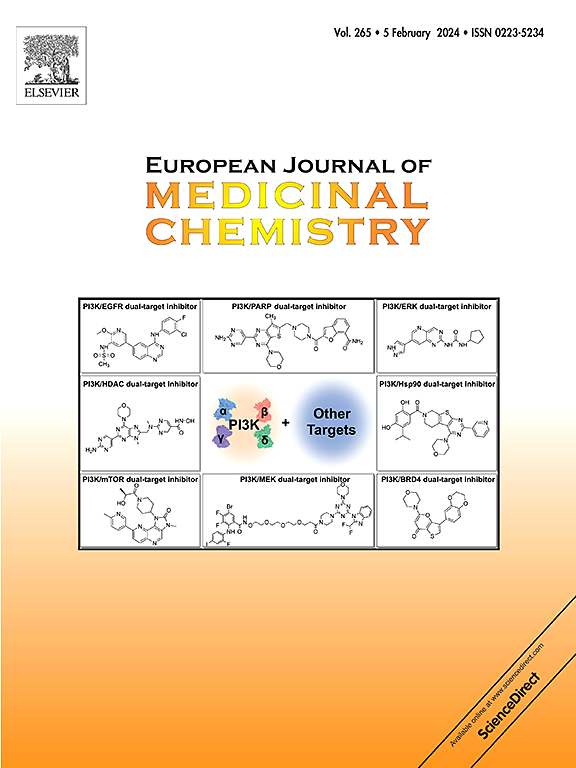Local enhancement of cationic charge density via polyamine side chain incorporation improves the selectivity of antimicrobial peptoids
IF 5.9
2区 医学
Q1 CHEMISTRY, MEDICINAL
引用次数: 0
Abstract
Antimicrobial resistance poses a critical threat to global health, necessitating the development of new therapeutics. Peptoids are synthetic analogs of peptides with an N-substituted glycine backbone and have been investigated for antimicrobial therapeutic applications due to their resistance to proteolysis and tunable structures. This study explores antimicrobial peptoids functionalized with polyamine side chains, leveraging the cationic nature of polyamines to enhance interactions with bacterial membranes. A structure-activity relationship (SAR) analysis was conducted to elucidate the influence of polyamine chain length and density on antimicrobial potency and selectivity. The optimized peptoids demonstrated potent activity against Gram-positive and Gram-negative bacteria, including multidrug-resistant strains, while maintaining low cytotoxicity toward mammalian cells. Mechanistic studies demonstrated that these peptoids employ multiple killing mechanisms, including membrane disruption, oxidative damage, and intracellular aggregation of proteins and nucleic acids. This work highlights the potential of polyamine-functionalized peptoids for developing next-generation antimicrobial agents and provides insights into the design principles for enhancing their efficacy and safety.


通过多胺侧链掺入局部增强阳离子电荷密度提高抗菌肽的选择性
抗菌素耐药性对全球健康构成严重威胁,需要开发新的治疗方法。类肽是具有n -取代甘氨酸骨架的肽的合成类似物,由于其耐蛋白水解和结构可调,已被研究用于抗菌治疗应用。本研究探索了多胺侧链功能化的抗菌肽,利用多胺的阳离子性质来增强与细菌膜的相互作用。采用构效关系分析(SAR)研究了多胺链长和密度对抗菌效力和选择性的影响。优化后的肽类对革兰氏阳性和革兰氏阴性细菌(包括耐多药菌株)具有强效活性,同时对哺乳动物细胞保持较低的细胞毒性。机制研究表明,这些类肽具有多种杀伤机制,包括膜破坏、氧化损伤和细胞内蛋白质和核酸聚集。这项工作强调了多胺功能化肽在开发下一代抗菌药物方面的潜力,并为提高其有效性和安全性提供了设计原则。
本文章由计算机程序翻译,如有差异,请以英文原文为准。
求助全文
约1分钟内获得全文
求助全文
来源期刊
CiteScore
11.70
自引率
9.00%
发文量
863
审稿时长
29 days
期刊介绍:
The European Journal of Medicinal Chemistry is a global journal that publishes studies on all aspects of medicinal chemistry. It provides a medium for publication of original papers and also welcomes critical review papers.
A typical paper would report on the organic synthesis, characterization and pharmacological evaluation of compounds. Other topics of interest are drug design, QSAR, molecular modeling, drug-receptor interactions, molecular aspects of drug metabolism, prodrug synthesis and drug targeting. The journal expects manuscripts to present the rational for a study, provide insight into the design of compounds or understanding of mechanism, or clarify the targets.

 求助内容:
求助内容: 应助结果提醒方式:
应助结果提醒方式:


